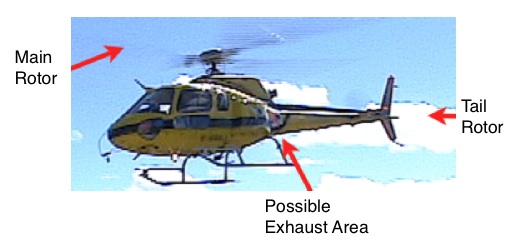DO NOT COPY - ALL contents - Copyright Protected
DRAM Ventures Inc. / www.firesafetraining.com
S-100a - Sections 11-15
DO NOT COPY - ALL contents - Copyright Protected
DRAM Ventures Inc. / www.firesafetraining.com
ContentsSection 11 - 15
Complete Course Table of Contents
DO NOT COPY - ALL contents - Copyright Protected
DRAM Ventures Inc. / www.firesafetraining.com
Section 11 Helicopters & Safety
Helicopters are used on almost every fire for a variety of reasons.
Some of these are:
- ferrying - transporting crews
- bucketing - cooling down hot spots
- long lining - moving equipment into the fire area
- observation
- infrared scanning
- mapping
- medical evacuations (medi-vac)
Helicopters have three main danger areas
- main rotor blade
- tail rotor blade
- exhaust (on some types such as the Hughes 500)

Some DO's and DON'Ts when working near helicopters:
- Never approach a helicopter unless you have been directed to do so AND you have been given basic instructions
- Never walk to the rear of a helicopter (behind the landing gear)
- Never run
- Do not load a helicopter unless you have been trained
- Never walk uphill when departing a helicopter
- Never walk downhill toward a helicopter
- Always communicate with pilot (eye contact and hand signals may work)
- Always make sure to stay back 30 meters (100 feet)
- Always make sure the helipad is clear of loose debris. (loose hose, sleeping bags, etc.)
- Always carry your hard hat or use a chin strap when in the vicinity of a helicopter
- Always carry your equipment waist height
- Head down, eyes up
- Shield your eyes from rotor wash debris (flying dust)
- If you are required to ride in a helicopter, tell your supervisor and the pilot that you have not had a helicopter safety training course
- Enter and exit on the left side if safe to do so (pilot can see you better) (NEVER WALK TO THE REAR OF THE HELICOPTER TO GET TO THE LEFT SIDE)
- Always fasten your seat belt
- Do not slam the door (pilot will advise you)
- When departing do not do so until the pilot advises you to
- When departing, fasten your seat belt behind you prior to getting out
NOTE: This review course is NOT a formal Helicopter Safety Review
Section 12 Air Tankers
Many fires in British Columbia will “see” air-tanker action. This may occur before you arrive or afterward. The fire retardant being dropped from the tankers has the potential to do serious harm if precautions are not taken by fire fighters (and the pilots).
There are some basic important precautions to take when air-tankers are “working” the fire you are on.
If you are told or become aware that air-tanker action is going to take place on “your” fire. Immediately move away at a right angle, from the proximity of the intended drop zone. Do not run. The air-tankers are led to the fire by a smaller aircraft called the “bird-dog”. On board is a pilot and a Forest Officer called an Air Attack Officer. The Air Attack Officer directs the air-tankers and will be in radio communication with the Incident Commander on the ground.
The “bird dog” plane will fly low over the intended drop zone and on the same flight path the tankers will follow. The “bird dog” plane will sound a series of yelping sirens as he passes overhead as a warning the air-tankers are not far behind.
You should be clear of the drop zone. However, if you are not - do not panic! Find a low spot - hollow - in the ground and lay face down. Face the direction the “bird dog” plane came from. Lay your hand tools behind you and hold your hard hat on with your hands. Do not take shelter behind snags (green, standing trees can be knocked over) or any object or debris that may bounce up and injure you. In most cases the worst that will happen to you is you will be covered with red fire retardant.
After the drop. There are usually more than one air-tanker drops therefore, stay where you are until you hear the all-clear. The all-clear will come from the “bird dog” flying low over the fire again, sounding a loud siren, similar to a police siren.
When the all clear is sounded, carefully get up, check all around you (and up) and move toward the rest of your crew. The fire retardant should be washed off your skin.
Be aware that it is very slippery to walk on.
Section 13 Heavy Equipment
Working in the same general area as heavy equipment, (i.e. bulldozers, back-hoes, excavators, feller-bunchers, etc.) require some extra precautions and considerations.
Section 14 WATCH OUT
Why do we watch out? Take a look at these two videos. WATCH - OUT
Workers must always keep in mind the W-A-T-C-H - O-U-T slogan for fire line safety.
W - weather dominates fire behaviour
A - action is based on what the fire is doing
T - try out at least two escape routes
C- communications, keep them clear and simple
H - hazards such as snags, flash fuels and dangerous terrain must be observed
O - observe changes in the weather
U - understand your instructions
T - think clearly, stay alert and keep calm at all times
Section 15 Evacuation Procedures
If you become separated from your crew, go immediately to one of the predetermined safe zones. If you are cut-off and unable to reach a safe area, travel in a downhill direction to find:
If an order to evacuate or to leave the fire for any reason, is given, fire fighters must:
In the event of a self-directed evacuation,(ONLY EXTREME DANGER) leave the fire area immediately and proceed to a designated safe zone. Inform your supervisor or other authority as soon as possible.